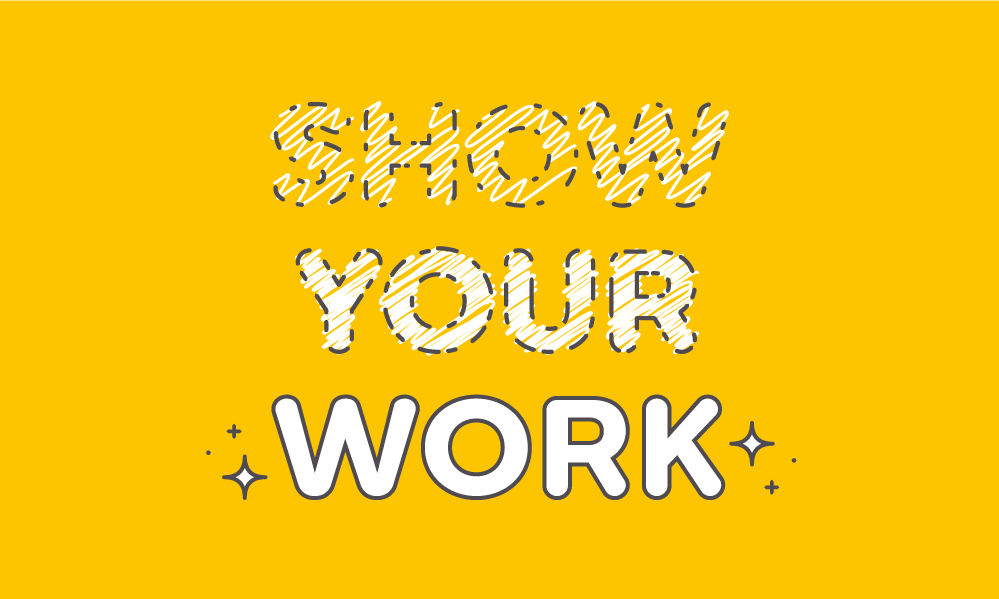
In high school, I had thoughts of becoming a math teacher after college. I love that math allows you to creatively solve problems and find answers. In mathematics, it’s critical that you’re able to show your work. Knowing the answer doesn’t matter nearly as much as being able to show that you understand how to get to the answer. The same can be said for design. Showing an understanding of the problem you’re trying to solve goes beyond just presenting a polished design. Opening up your design process to your team and your clients can lead to better results.
Design
Process
Get Feedback
Collaboration is key to successful projects. It can be hard to share your work, even with an internal team, when things don’t feel done. As a designer, I often work on a design until it’s perfect. Every detail, every font size, every margin must adhere to the design system I’m building. But what happens when the content isn’t right? What if the hierarchy of the content isn’t right? What if the visual hierarchy you’re building doesn’t support the goals of the project? Tweaking a design until it’s perfect only means you have more to adjust later when you’ve gathered feedback and things need to change – and they will need to change. Putting It Into Practice: If you’re struggling with a certain part of a design, reach out for feedback, even if the design is rough. This can unlock your work and let you move forward. It can also open up directions you hadn’t considered.Avoid the “Big Reveal”
This may feel uncomfortable but showing work in progress can save you a lot of time and headaches. I’ve found that some of the most successful projects come out of an open process that favors communication and collaboration over showmanship. At Aten, we work closely with clients in favor of a “big reveal,” treating clients like a part of the project team. We don’t unveil our designs with a flair like that of Don Draper straight out of Mad Men, where the reaction can be about our presentation skills as much as the design. We’re looking for confirmation that we heard the client and understand their needs, for a “Yes! This is what we wanted!” Our design process is built to show work regularly with the assumption that everything we show is open for feedback. It’s great when clients are thrilled with the results, but impressing stakeholders isn’t nearly as important as creating a design that meets user needs and business goals. You know those crime show scenes where they’re looking at a video and keep enhancing the video until it becomes clear? That’s what we’re doing with design. Putting It Into Practice: We start design with a discovery process that helps build our understanding of the client’s brand, the project needs and possible directions we can take with the design. From there, we work in broad strokes, starting with an Element Collage or Style Tiles. This lets us explore design outside of the context of a page comp and helps build the foundational elements we’ll need later in the design process. We then move on to what makes the most sense. Establishing visual hierarchy, page structure and navigation patterns are all important steps in the process. We show design work early and often, building a design system that can support the client’s content on any page of their site. We do page comps, prototypes, sketches – whatever makes the most sense to move us forward. A healthy design process isn’t a linear progression so much as a cycle of refinement.Share Your Design Process
One of the quickest ways I’ve found to make progress on a design is to open up my Sketch file and share my screen with the client. At the bare minimum, I can make adjustments on the fly that might have had to wait a week to review in the next working meeting. But things get exciting when I show how the design handles different images and content or how a layout could change to accommodate different content needs. My favorite thing is showing different design directions I’ve explored. This accomplishes a number of things. First, it shows an understanding of the needs of the project and that you’ve considered multiple ways of solving design problems. Second, it can remove the “What If” types of feedback where clients try to solve the design problem for you. Finally, this is a great way to help clients understand your thinking. You really are showing your work. Putting It Into Practice: The next time you’re working through a design process for a project, jump on a call with the client and share your working file. Don’t get hung up on a tour of the comp. They can see it just fine. Keep their feedback focused by walking them through the problems you’re trying to solve and the ways your design solves those problems. Sharing your working file on a video call can be risky. You may find yourself in a situation where you’re making changes you don’t agree with. Remember, just because you’re opening up your process doesn’t mean you’re letting go of the reins. Push back on feedback you disagree with. If you’re asked to make a change that’ll take a lot of time to implement, don’t do it on the call. And make sure it’s the right time to share the work. Sharing too early in the process can lead to more open-ended feedback. Ultimately, you need to use your gut to decide when it makes the most sense for your project. Your design process should be your own, but you don’t have to go alone. Share your thinking with your team and your clients, and you’ll find you have better relationships and better end results.Read This Next
- Website Design Audits: The Secret to Sustained Impact
- Celebrating Science: A New Logo & Identity for Sanford Lab’s Annual Science Festival
- 6 UX Exercises to Keep Users at the Center of your Website Redesign
- 6 Guidelines for Accessible Website Design
- Design and User Strategy Workshops Lead to Peak Performance for the City of Boulder’s New Site
Skip to footer
Comments
